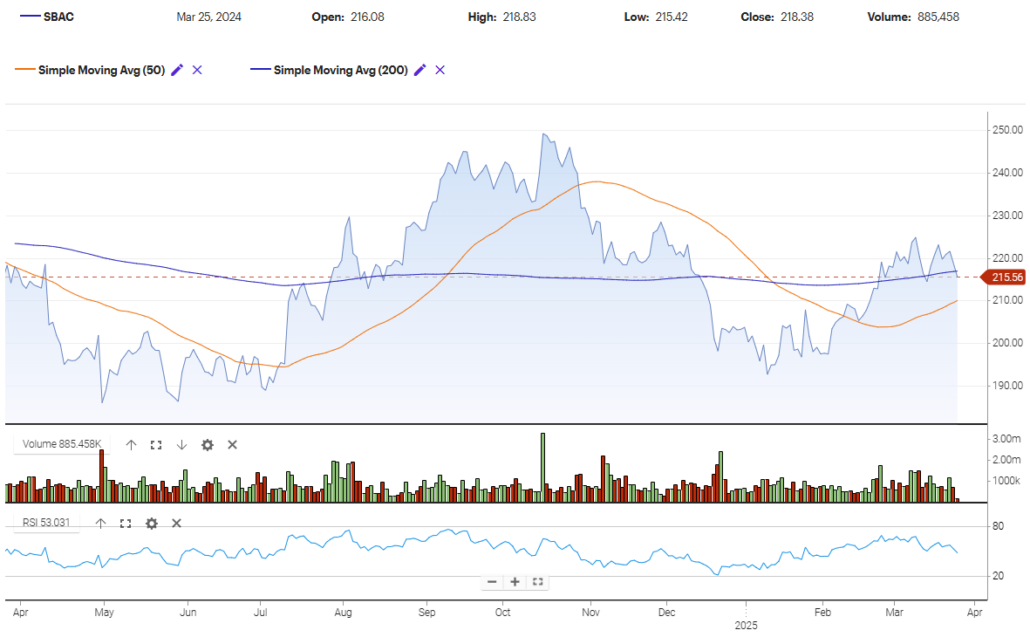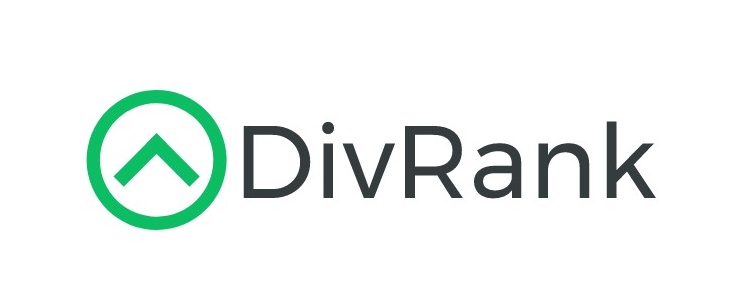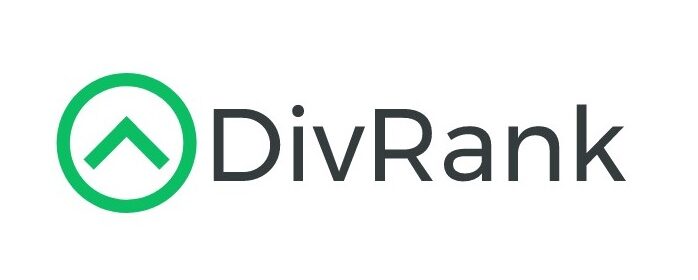Updated 3/26
SBA Communications isn’t your typical real estate investment trust. Instead of shopping centers or office buildings, this REIT deals in cell towers and wireless infrastructure—structures that quietly power everything from your morning texts to your GPS. The company builds, leases, and maintains wireless towers across the Americas, offering the kind of steady, utility-like cash flow that dividend investors appreciate once they dig a little deeper.
It might not have the headline appeal of a tech stock or the yield of a utility, but SBA has been quietly building a reputation as a dependable dividend payer with growth potential baked in.
Recent Events
Over the past year, SBA has been operating in a challenging but manageable environment. The company turned in a full-year earnings performance that showed strength where it counts—net income reached $749 million and earnings per share climbed to $6.93. That represented a healthy 58% year-over-year jump in quarterly earnings. Revenue came in at $2.68 billion, up modestly at 2.8%.
The climb hasn’t come without headwinds. Higher interest rates have taken a bite out of REIT valuations across the board, and SBA hasn’t been immune. Its debt levels have climbed to $15.76 billion, a reflection of the capital-intensive nature of the business. Still, with a market cap hovering around $23 billion and a low beta of 0.74, this is not a stock swinging wildly with the broader market. It’s slow, steady, and predictable—traits that dividend investors tend to like.
A fresh dividend payment is scheduled for March 27, another reminder that despite all the noise in the market, SBA keeps delivering on its commitment to return value to shareholders.
Key Dividend Metrics
📈 Forward Dividend Yield: 2.07%
💸 Annual Dividend: $4.44 per share
🧮 Payout Ratio: 56.48%
📅 Upcoming Dividend Date: March 27, 2025
📉 5-Year Average Yield: 1.06%
🌱 Dividend Growth (Year-over-Year): 13.3% increase
Dividend Overview
SBA’s dividend profile might not jump off the page at first glance. The current yield just cleared 2%, which doesn’t usually turn heads. But here’s the catch—it’s been growing fast. In fact, the payout has increased from $3.92 to $4.44 over the past year. That’s a 13.3% hike, not something you typically see from a company with such a stable business model.
What’s more, the yield is now nearly double its five-year average. That gap suggests the market hasn’t quite caught up to the dividend growth story SBA is building. It’s not often you see a dividend grow this quickly without the stock price running ahead of it.
The payout ratio sits just under 57%, leaving plenty of room for future increases. That’s the kind of balance dividend investors should look for—enough of a payout to matter, but not so much that it puts stress on the business.
Dividend Growth and Safety
If consistency is the hallmark of a great dividend stock, SBA is checking the right boxes. The company’s dividend growth is real and sustainable. A 13% increase in the past year wasn’t a fluke—it was part of a deliberate, disciplined plan.
The cash flow picture supports this. SBA pulled in $1.33 billion in operating cash flow over the past year, comfortably covering its dividend obligations. Yes, levered free cash flow came in negative, but that’s typical for a company in expansion mode. Much of SBA’s investment goes into building and upgrading towers—long-term assets that pay off over time.
The dividend doesn’t feel forced. It’s backed by real earnings, predictable revenue, and a cautious approach to leverage. Management seems committed to steady increases without stretching the balance sheet too far.
Chart Analysis

Current Phase and Market Cycle Behavior
Looking at the SBAC chart, the price action over the past year suggests a classic Wyckoff-style structure that points toward the latter stages of accumulation, transitioning into early markup. From late summer through mid-autumn, the stock carved out a base, forming multiple higher lows around the $190 range. This signaled the presence of smart money quietly stepping in and absorbing supply. The breakout above the 50-day moving average in early 2025 marked the end of that accumulation zone.
Since then, SBAC has been grinding higher, making a series of higher highs and higher lows, a telltale sign that it’s entered the early markup phase. However, the move hasn’t been explosive—more of a steady stair-step than a sprint. That’s typically how institutional accumulation transitions into markup: slow, deliberate, and with volume that picks up at key support levels.
Moving Averages
The 50-day moving average (orange line) has recently turned upward and just crossed back above the 200-day moving average (blue line), forming what many refer to as a golden cross. This technical event often confirms a shift in sentiment toward a more bullish stance. What’s notable here is that price action is currently oscillating just above both moving averages, suggesting traders are testing the strength of this crossover.
The 200-day moving average remains mostly flat, which tells us that the long-term trend has not fully reversed yet. It reflects a market that’s still in the process of digesting prior downside. For SBAC to sustain a move higher, the price will need to stay consistently above both these averages in the weeks ahead.
Volume Behavior
Volume has played a supporting role throughout this chart, with spikes aligning with key breakout levels. During the bottoming phase around November and December, we saw volume pick up around support—a sign that stronger hands were likely stepping in. Since then, volume has been relatively steady, with occasional green bars showing buying interest on the way up.
However, the past couple of weeks have seen volume begin to fade, particularly on up days. This suggests that momentum may be stalling, at least temporarily. If we start seeing red bars increase with higher volume, that would signal increased distribution and could threaten the current uptrend.
Relative Strength Index (RSI)
The RSI is currently sitting at around 53, which is right in neutral territory. It had previously touched into overbought levels near 70 in early March, before pulling back. That overbought reading aligned with the short-term top near $225. The current RSI suggests that the market is neither overbought nor oversold, giving room for the next leg to develop in either direction depending on volume and price behavior.
Candle Analysis – Last Five Sessions
Over the last five trading sessions, the candles have been tight and range-bound, indicating indecision. Wicks on both sides—especially upper wicks—show that there’s some selling pressure at higher levels. The most recent candle shows a modest close near the highs of the day after a dip early on, pointing to intraday buying support. Still, none of the past five candles show strong conviction from bulls.
The smaller real bodies and presence of wicks suggest a pause after the recent rally, with short-term traders potentially taking profits while new buyers are waiting for confirmation before jumping in.
This is a digestion zone, and the next few candles will be key in telling whether buyers are ready to push above resistance near $220 or if the stock will pull back toward the $210-$212 support zone.
Analyst Ratings
📊 SBA Communications Corp. (SBAC) has recently seen mixed sentiment from analysts, with the current consensus rating standing at Moderate Buy from a group of 14 Wall Street analysts. The breakdown includes 10 analysts suggesting a Buy and 4 maintaining a Hold stance.
🎯 The average 12-month price target for the stock is $252.85, implying an upside potential of around 17.98% from the recent trading level of $214.70. There’s a decent spread among estimates, with the high target at $300 and the low coming in at $225, reflecting some divergence in expectations depending on the time horizon and risk assumptions.
📝 A few recent updates stand out. Wells Fargo adjusted their target from $210 to $225, keeping their Equalweight rating. Jefferies followed with a bump in their target to $221, up from $205, while continuing to rate the stock as Hold. Barclays revised its target downward from $254 to $240 but maintained an Overweight view, suggesting long-term conviction despite short-term adjustments.
💬 These moves are largely tied to macro factors and updated earnings guidance. Analysts are keeping a close eye on SBA’s cash flow resilience in the face of higher interest rates, as well as its continued tower buildouts in key international markets. While the dividend growth has caught attention, the heavy debt load and muted top-line growth seem to be capping bullish sentiment.
🔍 Overall, the market appears to see moderate upside, but there’s a clear wait-and-see tone in some of the recent commentary, with analysts looking for stronger forward guidance or a clearer macro tailwind before turning more aggressively bullish.
Earnings Report Summary
Solid Finish to the Year
SBA Communications wrapped up 2024 on a strong note, showing some healthy momentum in both its core operations and its financial positioning. The company brought in $178.8 million in net income for the quarter, which worked out to $1.61 per share. That’s not a small feat in this environment. More importantly for REIT-watchers, the adjusted funds from operations (AFFO) came in at $3.47 per share—always a key number for this kind of business.
Growth Where It Matters
Revenue from site leasing, which is really the heart of what SBA does, climbed to $646.3 million. That’s a 1.6% bump from the same quarter last year. It’s not explosive growth, but in a stable, contract-based business like tower leasing, steady progress like this counts. Site development revenue saw an even bigger boost, jumping more than 21% year-over-year to hit $47.4 million. That piece of the business can be lumpy, so seeing a lift like that is encouraging.
Margins also held up well. Tower cash flow margin ticked up to 81.7%, and adjusted EBITDA reached $489.3 million, up nearly 2%. All in, the EBITDA margin was 70.6%, which shows the business remains efficient even as it expands.
Capital Investments and Expansion
SBA stayed active on the infrastructure front, acquiring seven new tower sites for a little over $1 million and building 159 new towers during the quarter. Total capital spending hit $87 million, with most of it—almost $70 million—going toward strategic builds and enhancements.
They also made a dent in leverage. The company lowered its net debt to annualized adjusted EBITDA ratio to 6.1 times, the lowest level in its history. With $1.7 billion in cash and no borrowings on its $2 billion revolving credit line, SBA is keeping its financial flexibility intact.
Dividend Hike and International Streamlining
In a move that dividend investors should appreciate, SBA’s board raised the quarterly dividend by 13%, taking it to $1.11 per share. That payment went out on March 27 to shareholders of record earlier in the month.
Management also hinted at a tighter focus going forward. They’ve already exited the Philippines and plan to wind down operations in Colombia. That should allow them to hone in on markets where they see stronger returns.
Overall, SBA closed out the year with a measured, growth-minded approach—balancing expansion, efficiency, and shareholder returns.
Financial Health and Stability
SBA does carry a lot of debt—just under $16 billion at last check. And with just under $190 million in cash, that might raise a few eyebrows. But in the world of REITs, especially one focused on infrastructure, this isn’t out of line. These companies typically operate with high leverage because their assets are long-lived and their cash flows are stable.
The current ratio is just below 1, suggesting short-term liquidity is tight, but manageable. This isn’t a company swimming in cash, but it doesn’t need to be. Its clients—wireless carriers—sign long-term leases. That brings predictability, which is gold in this space.
Negative book value per share might look odd at first, but that’s due to heavy depreciation on tower assets. It’s more of an accounting quirk than a sign of trouble. More relevant are the company’s operating margin (over 57%) and return on assets (8.83%)—both solid numbers that reflect a well-run business with reliable cash generation.
Valuation and Stock Performance
SBA’s stock price hasn’t been on fire recently. It’s trading around $214, down from a 52-week high of $252. That’s a dip of less than 1% over the year—a flat performance compared to a rising S&P 500. But the stock hasn’t been falling off a cliff either. It’s just been treading water.
That could present an opening for income-focused investors. The current valuation puts the forward price-to-earnings ratio at 25.77, a discount from the trailing P/E of over 30. The PEG ratio sits around 1.84, suggesting growth is reasonably priced.
SBA doesn’t look cheap on a strict valuation basis, but it doesn’t look overcooked either. The EV/EBITDA ratio of 26.14 reflects the premium the market places on stable, long-term cash flows—especially in a business with high barriers to entry.
Risks and Considerations
The biggest challenge for SBA right now is the interest rate environment. High rates increase borrowing costs and make dividend-paying stocks less attractive compared to bonds. That’s a macro pressure that every REIT is feeling, and SBA’s large debt load makes it more sensitive than most.
Another factor to watch is industry consolidation. If the number of wireless providers shrinks, there’s less demand for new tower space. That could limit SBA’s growth prospects in the U.S., although its international footprint helps offset some of that.
There’s also currency and regulatory risk tied to its Latin American operations. While the exposure adds diversification, it can also bring volatility. Investors need to weigh that carefully.
Lastly, some might see the yield as too low. At just over 2%, it doesn’t scream “high-income stock.” But that misses the bigger picture—this is a growing dividend, not a stagnant one.
Final Thoughts
SBA Communications is one of those stocks that can fly under the radar, especially in dividend conversations. The yield won’t land it on many “top 10” lists, but the growth rate, consistency, and safety of its payout are hard to ignore.
This is a business built for the long haul. The towers it owns are essential, the contracts are long-term, and the cash keeps flowing in. For investors who appreciate steady income with room for growth, SBA offers a compelling mix.
It’s not the flashiest stock in the REIT space, but it doesn’t need to be. Quietly compounding dividends and maintaining financial discipline can be just as rewarding in the long run.

